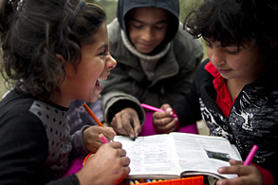Education[editar]
Formal educational levels, affected by housing segregation and by a poor health situation, are also profoundly deficient, and determine Roma’s limited access to the labour market. According to a comparative study of 7 EU member states realised in 2009, circa 44% of surveyed Roma had not completed primary education, while only 24% had completed secondary studies and an insignificant minority had a university degree. However, 87% of Roma children aged 6 to 15 were enrolled in school. A more recent survey of 11 member states by the EU Agency for Fundamental Rights (FRA) showed that:
- On average, only one out of two Roma children surveyed attend pre-school or kindergarten;
- During compulsory school age, with the exception of Bulgaria, Romania and Greece (where respectively 16%, 23% and 35% do not attend school), nine out of ten Roma children aged 7 to 15 are reported to be in school, indicating progress in terms of enrolling Roma children in compulsory school in the past decade, following the ‘lost’ decade of the 1990s in terms of schooling in Eastern and Central European countries.
- Participation in education drops considerably after compulsory school: only 15% of young Roma adults surveyed complete upper-secondary general or vocational education.
- The enrollment rates of Roma children are proportional to the persistence of child labour among Roma households. The proportion of Roma children aged 7 to 15 who work outside of the home varies according to the country, but averages 5%, while it is virtually non-existent among the non-Roma European population. In Greece and Romania, more than 10% Roma children are reported to be working outside the home, while in Italy, France and Bulgaria the proportion reaches 6%. This work consists primarily in the collection of objects for reselling or recycling, or begging on the street for money. Other activities include working in a shop, on a farm, in a market or selling things in the streets, running errands or guarding cars.
In Spain, a survey by the FSG have shown that the dropout rate of Roma pupils in compulsory secondary education reaches 80%, while illiteracy rates among Roma adults in Spain are very high.
Segregated education and special-needs schools documented in several central and Eastern European states by the Roma Education Fund and the UNDP have perpetuated the educational inequities affecting the Roma. In Central and Eastern European states, according to respondents of a UNDP survey carried out in 2003 (data for 2011 pending publication by FRA/UNDP/EC), circa 14% of the children attended classes comprised mostly of Roma, in so-called ‘Gypsy schools’ or ‘special schools for the mentally disabled’ (2.5% in Bulgaria, 4.7% in Romania, 12% in the Czech Republic, 16% in Hungary, 19% in Slovakia, and 27% in the Czech Republic). However, desegregation efforts such as the Czech government’s abolishment of special education schools targeting Roma and the Hungarian government’s substantial investments in integrated schooling, supported by the EU institutions and the Roma Education Fund, are beginning to bear fruits despite the practical difficulties of overcoming de facto, spatial segregation.
To find more about education and Roma people and about our work in education








